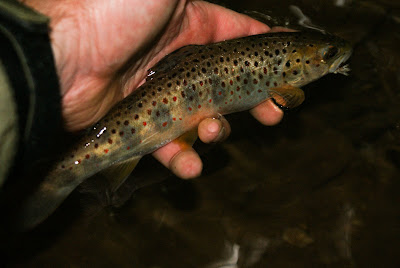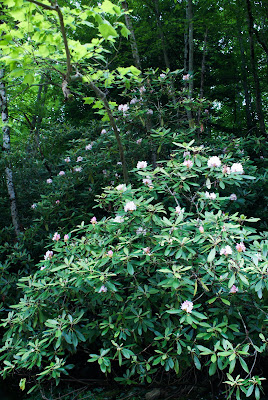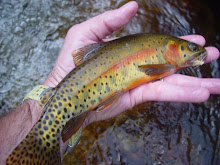
This particular piece of information caught my young friend's attention.

The plan was to take Red Creek trail to Big Stonecoal trail (1.5 miles), Big Stonecoal trail to Rocky Point trail (1.2 miles), Lion's Head Spike trail (0.5 miles), Rocky Point trail back to Red Creek trail (1.8 miles), then Red Creek trail back to the trailhead (3.2 miles). With a little bushwhacking thrown in, the round trip would be a little over 8 miles.
The first flat 1.5 miles went fairly uneventful, until we had to cross Red Creek to get to Big Stonecoal trail. At this point my friend informed me he had already developed blisters on his heels. I had loaned him a pair of hiking shoes but I did not notice he had put on "footies" - not a good choice for these rugged, rocky trails.
In his own words, he would "man up" and keep going. The next 1.2 miles were uphill the entire length. Once we hit the first switchback I looked for the cairns that would signal the beginning of the first bushwhacking adventure. At this point on Big Stonecoal trail there are supposedly some very nice falls below the trail in Big Stonecoal run.
The bushwhacking would be quite the adventure! The rhododendron thickets were very difficult to maneuver through, but I would take the lead and make a trail. I got to a certain point where I could see through the rhododendron that the solid ground seemed to disappear. So it was back up the mountain, around the ridge and try to pick my way down again. This would lead to the same result, so I repeated this and the third time was a charm as I finally able to make it to the stream.
I would not be disappointed and the rain the previous day added some water to the stream, adding needed flow to the waterfalls and cascades.
These next few shots ran consecutively on Big Stonecoal:


 As we worked our way downstream through this very rugged section of stream, I learned why the ground seemed to disappear in the rhododendron thicket - there was no ground! It's a good thing I decided not to push through the thicket, had I done so it would have been a real bad day.
As we worked our way downstream through this very rugged section of stream, I learned why the ground seemed to disappear in the rhododendron thicket - there was no ground! It's a good thing I decided not to push through the thicket, had I done so it would have been a real bad day. After working our way past this obstacle we found a route we could work our way back up to the trail. It was nearly straight up but at least we weren't fighting the rhododendron.
After working our way past this obstacle we found a route we could work our way back up to the trail. It was nearly straight up but at least we weren't fighting the rhododendron.Once back on Big Stonecoal trail, our next destination was Rocky Point trail and the Lion's Head spike trail. I was concerned I would not find this spike trail but again rock cairns marked the trail.
It was another quick uphill climb and the trail leveled out in this pine grove. The pines were obviously planted in nearly perfect rows, possibly by the CCC (Civilian Conservation Corp).
 Once at the end of the pine grove we were looking for a small trail out to the rock outcroppings that would contain Lion's Head. The trail was easy enough to find and the view was simply amazing.
Once at the end of the pine grove we were looking for a small trail out to the rock outcroppings that would contain Lion's Head. The trail was easy enough to find and the view was simply amazing.
Can you make out the Lion's Head?

After taking a nice break while enjoying the scenery and a quick lunch, it was backtracking to Rocky Point trail. Once we returned to Rocky Point it was back around the point below the Lion's Head formation and the junction with Red Creek trail. By the way, Rocky Point trail is aptly named as about a mile of this trail is composed of softball-sized limestone cobble - real ankle breakers.
The junction with Red Creek trail is well above Red Creek and the trail downhill to the creek is much steeper than the trail up Big Stonecoal. I think we chose our route wisely.
Once down and back across Red Creek, my next goal on the way out was to locate Thea's Falls. I had the coordinates but traveling from the north Thea's is easily spotted from the trail. Another beautiful set of falls in Dolly Sods.
 I had one more spot I wanted to visit before we headed toward Seneca Rocks and Spruce Knob. There is an overlook with a great view of North Fork Mountain and the Chimney Rocks formation.
I had one more spot I wanted to visit before we headed toward Seneca Rocks and Spruce Knob. There is an overlook with a great view of North Fork Mountain and the Chimney Rocks formation.
 Following a quick stop at the Seneca Rocks Visitors Center, it was on to Spruce Knob where we would set up camp for the night and meet another friend for Sunday's journey.
Following a quick stop at the Seneca Rocks Visitors Center, it was on to Spruce Knob where we would set up camp for the night and meet another friend for Sunday's journey.This is another view of North Fork Mountain and the North Fork of the South Branch of the Potomac River valley (that's a mouthful).
From the overlook we made it to the campground, pitched the tents, and had dinner. These would be firsts for my young friend: first night in a tent and first freeze-dried meal.
Following dinner we made a quick trip to the top of Spruce Knob, hoping to catch a sunset over the Seneca valley but we were too late. By the time we returned to camp our third member of the Sunday adventure had arrived. It was a couple of quick introductions, a little conversation, then off to catch a few winks.
The plan for Sunday was up before sunrise and back to the Spruce Knob summit with hopes to catch a sunrise over North Fork Mountain. As with the attempt to catch sunset, we missed sunrise due to heavy fog. However, we did find temperatures down to 41 degrees (in July) and a wind chill that most likely pushed it into the upper 30's.
Having missed the sunrise, we returned to camp, packed up and hit the trailhead.
 I was anxious to hit this trail, as it would be the personal completion of Seneca Creek. I had traveled Seneca from the mouth to just below Judy Springs and this section would complete the "puzzle" which is the entire Seneca Creek watershed.
I was anxious to hit this trail, as it would be the personal completion of Seneca Creek. I had traveled Seneca from the mouth to just below Judy Springs and this section would complete the "puzzle" which is the entire Seneca Creek watershed. The next stop on our journey was the upper falls of Seneca just above the junction with Horton Trail. As an indication of how low the water was, this set of falls normally has two major streams over the falls.
The next stop on our journey was the upper falls of Seneca just above the junction with Horton Trail. As an indication of how low the water was, this set of falls normally has two major streams over the falls. Once at the deepest point in our adventure, we stopped for some photos and a quick bite to eat. The next task was to put my young friend on the first fish of his life - he had never been fishing before. With the low water I had my work cut out for us. It was difficult to put a first-time fisherman on fish with the low water and trying to do it with a fly rod compounded the difficulty.
Once at the deepest point in our adventure, we stopped for some photos and a quick bite to eat. The next task was to put my young friend on the first fish of his life - he had never been fishing before. With the low water I had my work cut out for us. It was difficult to put a first-time fisherman on fish with the low water and trying to do it with a fly rod compounded the difficulty. We continued to make our way back upstream toward Judy Springs, hoping to put him on a fish but with the low water it just didn't happen. At least he can't say he has "never been fishing" now.
We continued to make our way back upstream toward Judy Springs, hoping to put him on a fish but with the low water it just didn't happen. At least he can't say he has "never been fishing" now. The hike out was uphill the entire way but the uphill grade was not noticeable and the trail was in much better shape than the day prior - or at least not as rugged. The total distance for this day when we returned to the trailhead? A little over ten miles.
The hike out was uphill the entire way but the uphill grade was not noticeable and the trail was in much better shape than the day prior - or at least not as rugged. The total distance for this day when we returned to the trailhead? A little over ten miles. I think Almost Heaven West Virginia showed itself very well for our visitor!
I think Almost Heaven West Virginia showed itself very well for our visitor! Shortly after, I caught a second. A little bigger - things were looking good:
Shortly after, I caught a second. A little bigger - things were looking good: That second brookie is a typical average fish in almost every brookie stream I have fished in West Virginia, but at the risk of getting ahead of myself this would not be the case today. The next flat pool produced this guy:
That second brookie is a typical average fish in almost every brookie stream I have fished in West Virginia, but at the risk of getting ahead of myself this would not be the case today. The next flat pool produced this guy: So it started, nearly every little pocket produced a fish and even the long slow pools produced brookies on a slow drift. I don't know if it was the overcast skies or the low 50-degree air temps, but the day was definitely one of my best (if not THE best) brookie fishing days in West Virginia.
So it started, nearly every little pocket produced a fish and even the long slow pools produced brookies on a slow drift. I don't know if it was the overcast skies or the low 50-degree air temps, but the day was definitely one of my best (if not THE best) brookie fishing days in West Virginia.  By this time I had easily hit double digits but my friend was still picking up a few here and there until he switched flies. I typically fish small flies for the brookies, and they produce, but when I saw what m friend had switched to I was amazed. He had switched to a very large (size 10?) grasshopper with a caddis wing and he was absolutely hammering them now.
By this time I had easily hit double digits but my friend was still picking up a few here and there until he switched flies. I typically fish small flies for the brookies, and they produce, but when I saw what m friend had switched to I was amazed. He had switched to a very large (size 10?) grasshopper with a caddis wing and he was absolutely hammering them now. The little palm-sized camera does take good macros:
The little palm-sized camera does take good macros: It also takes nice underwater shots too:
It also takes nice underwater shots too: And so it would continue, for over six hours we caught fish at an amazing rate. I would guess between the two of us we had to be pushing triple digits. The amazing thing was the average size. Most brookie streams I have fished have an average size of four to six inches; this stream average fish was six to eight inches with several fish over the ten-inch mark!
And so it would continue, for over six hours we caught fish at an amazing rate. I would guess between the two of us we had to be pushing triple digits. The amazing thing was the average size. Most brookie streams I have fished have an average size of four to six inches; this stream average fish was six to eight inches with several fish over the ten-inch mark! The last fish of the day for my friend had a strong gold tint to it. It's hard to tell in this photo, but you can almost see the monstrosity of the fly he was fishing.
The last fish of the day for my friend had a strong gold tint to it. It's hard to tell in this photo, but you can almost see the monstrosity of the fly he was fishing. The other amazing feature of this stream was the resemblance (we both agreed) to Roaring River in Rocky Mountain National Park. Both streams have been absolutely scoured by floods. Minus the hardwoods you can see resemblance of the streams
The other amazing feature of this stream was the resemblance (we both agreed) to Roaring River in Rocky Mountain National Park. Both streams have been absolutely scoured by floods. Minus the hardwoods you can see resemblance of the streams Roaring River in RMNP:
Roaring River in RMNP: Before we started our mile and a half hike back to the vehicle, I hit a hole where one of the feeders dumps in - for the second time. I had already caught three out of this junction pool but one more drift had a brookie come about two feet out of the water as he missed the big fly and another drift resulted in yet another eight to ten inch brookie - time to call it a day.
Before we started our mile and a half hike back to the vehicle, I hit a hole where one of the feeders dumps in - for the second time. I had already caught three out of this junction pool but one more drift had a brookie come about two feet out of the water as he missed the big fly and another drift resulted in yet another eight to ten inch brookie - time to call it a day. With the rain continuing, I chose to leave the DSLR in the car. It's a shame because this little stream had some beautiful moss-covered rocky runs of many little brookie streams I have fished.
With the rain continuing, I chose to leave the DSLR in the car. It's a shame because this little stream had some beautiful moss-covered rocky runs of many little brookie streams I have fished.
 I ended up stinging a couple more and picking up a total of four wild browns. These wild browns had some amazing features. The adipose fin on this one was blood red and the main rays of the caudal fin were also a brilliant red. The heavy canopy made photos with natural lights nearly impossible, so I used the built-in flash which, flooded out the colors.
I ended up stinging a couple more and picking up a total of four wild browns. These wild browns had some amazing features. The adipose fin on this one was blood red and the main rays of the caudal fin were also a brilliant red. The heavy canopy made photos with natural lights nearly impossible, so I used the built-in flash which, flooded out the colors. I had climbed a considerable distance when I decided the scramble out would not be worth any further climbing. I did not catch the third species, the brook trout, but then again I've never had much success fishing for brookies in seriously stained water. I'll keep this stream on my list and hit it again when I can find it running clear.
I had climbed a considerable distance when I decided the scramble out would not be worth any further climbing. I did not catch the third species, the brook trout, but then again I've never had much success fishing for brookies in seriously stained water. I'll keep this stream on my list and hit it again when I can find it running clear. Even though we fought off rain for two days, it was a great time to be in the mountains of West Virginia. The state flower, the rhododendron was blooming everywhere.
Even though we fought off rain for two days, it was a great time to be in the mountains of West Virginia. The state flower, the rhododendron was blooming everywhere. The blooming rhododendron was just a bonus on top of the memorable day we had on the first stream.
The blooming rhododendron was just a bonus on top of the memorable day we had on the first stream.

